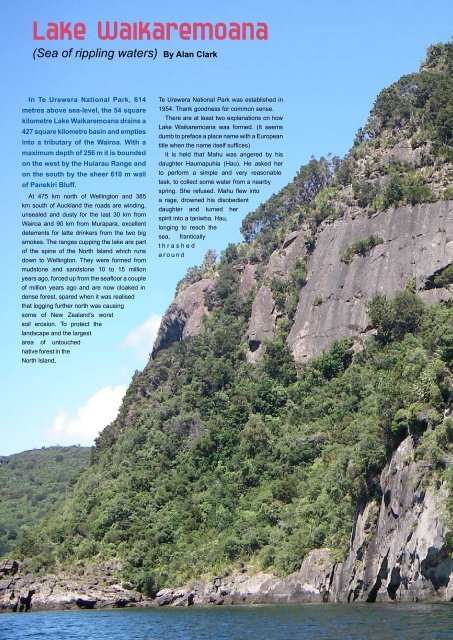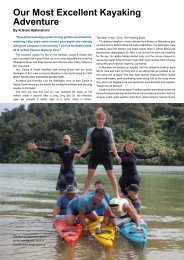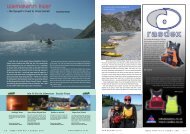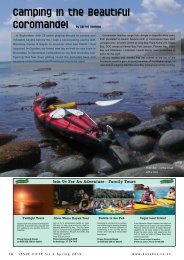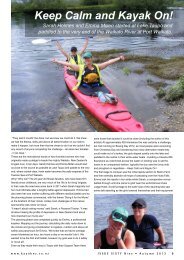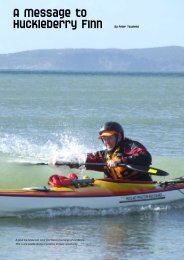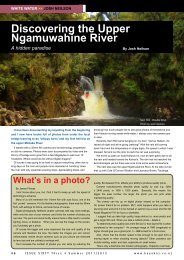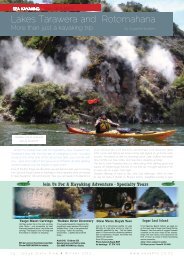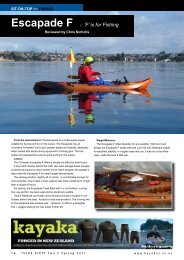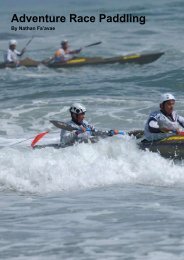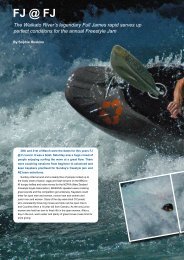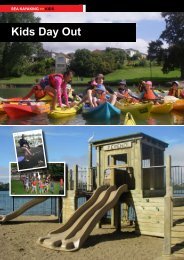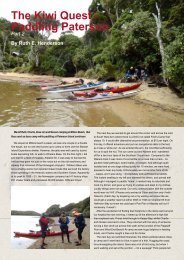Lake Waikaremoana - New Zealand Kayak Magazine
Lake Waikaremoana - New Zealand Kayak Magazine
Lake Waikaremoana - New Zealand Kayak Magazine
- No tags were found...
Create successful ePaper yourself
Turn your PDF publications into a flip-book with our unique Google optimized e-Paper software.
<strong>Lake</strong> <strong>Waikaremoana</strong>(Sea of rippling waters) By Alan ClarkIn Te Urewera National Park, 614metres above sea-level, the 54 squarekilometre <strong>Lake</strong> <strong>Waikaremoana</strong> drains a427 square kilometre basin and emptiesinto a tributary of the Wairoa. With amaximum depth of 256 m it is boundedon the west by the Huiarau Range andon the south by the sheer 610 m wallof Panekiri Bluff.At 475 km north of Wellington and 385km south of Auckland the roads are winding,unsealed and dusty for the last 30 km fromWairoa and 90 km from Murapara, excellentdeterrents for latte drinkers from the two bigsmokes. The ranges cupping the lake are partof the spine of the North Island which runsdown to Wellington. They were formed frommudstone and sandstone 10 to 15 millionyears ago, forced up from the seafloor a coupleof million years ago and are now cloaked indense forest, spared when it was realisedthat logging further north was causingsome of <strong>New</strong> <strong>Zealand</strong>’s worstsoil erosion. To protect thelandscape and the largestarea of untouchednative forest in theNorth Island,Te Urewera National Park was established in1954. Thank goodness for common sense.There are at least two explanations on how<strong>Lake</strong> <strong>Waikaremoana</strong> was formed. (It seemsdumb to preface a place name with a Europeantitle when the name itself suffices)It is held that Mahu was angered by hisdaughter Haumapuhia (Hau). He asked herto perform a simple and very reasonabletask, to collect some water from a nearbyspring. She refused. Mahu flew intoa rage, drowned his disobedientdaughter and turned herspirit into a taniwha. Hau,longing to reach thesea, franticallyt h r a s h e da r o u n d
around the outside. We made a brew and warmed up before erectingtents and hammocks.This, our first camp ground on Maori land at Tapuaenui Bay onPuketukutuku Peninsula, is compact, sheltered from wind and next toa kiwi reserve. In 1992 it was realized that stoats were massacring thekiwis. In 2003, the neck of the 1500 hectare peninsula was fenced andabout 1400 traps are now laid along lines in it and the neighbouringPukehou area. When the kiwi population on the peninsula was surveyedin 1993, there were 24 adult kiwis. By 2005, the population had trebled to76. The aim is to have between 150 - 200 kiwi . Many campers, like us,will enjoy the magical experience of falling asleep listening to the ancientcalls of kiwi and morepork.We had a swim and set off for the second day in promising weather.Unhappily it soon turned foul with more wind and showers. We paddledround the peninsula, through The Narrows (Te Kauangamania) toWaiharuru hut and paused for lunch. Our next camp at Maraunui Bayproved to be an exposed open grass area with a most welcome DOCshelter. We dried our gear and enjoyed the open fire.As so often by a lake, we woke to a still, crisp morning with a low mistover the water. But this was special. Here Hine-pukohu-rangi, woman ofmist and cloud, and the mountain Te Maunga created the Tuhoe iwi, thechildren of the mistSpirits high we paddled into the mist exploring side arms, waterfalls,creeks and amazing geological forms. The mist cleared, the lake stayedcalm, the air warmed, the company was good. We returned to MaraunuiBay where clothes and camp gear were dry and laughter echoed offbluffs. To stretch our legs we walked to the Korokoro Falls, truly a ‘mustsee’ . Some can enjoy a high pressure and rather cold shower!That evening, after swims and dinner we sat round the fire under thestars, and helped by a wee dram told dubious yarns to kindred souls. Itwas a natural high.
The next morning, again paddling into the mist, we reached the baseof Panekiri Bluff. I looked almost straight up to the peak 600 m above.Awed, I realized how small we humans are. We practised synchronisedswimming with the London Olympics in mind! Our final performance wason the eastern side of the lake in a bay with a smooth white sandy bottom.The shallow warm(ish) water brought the tropics rather than London tomind.With around 80 km of paddling behind us, we reached the motorcamp, sorted our gear and relaxed for another night, this time with hotshowers and flushing toilets, oh what luxuries.Returning to Wellington, one of the group received a text remindinghim that this day was the festival of Holi. Pyush, otherwise known as“Fred and Bob” is Indian. He explained that it is a festival in which bodiesare covered in paint. It sounded very appropriate but perhaps withoutthrowing paint all over each other. That is not the sort of thing kiwis dothat often. The six days away with this Yakity Yak mob were, in a differentway, just as colourful.Discover the World with...THE WORLD’S QUIETEST ROOF RACKIntroducing Prorack’s Whispbar TM .The most innovative, technicallyadvanced roof rack system thatwill radically reduce drag and fuelconsumption. Now that’s brilliantKiwi ingenuity!Now available from your localCanoe & <strong>Kayak</strong> store.Visit www.prorack.co.nz to see it on your carwww.kayaknz.co.nzISSUE FIFTY Seven • Summer 2010 19


